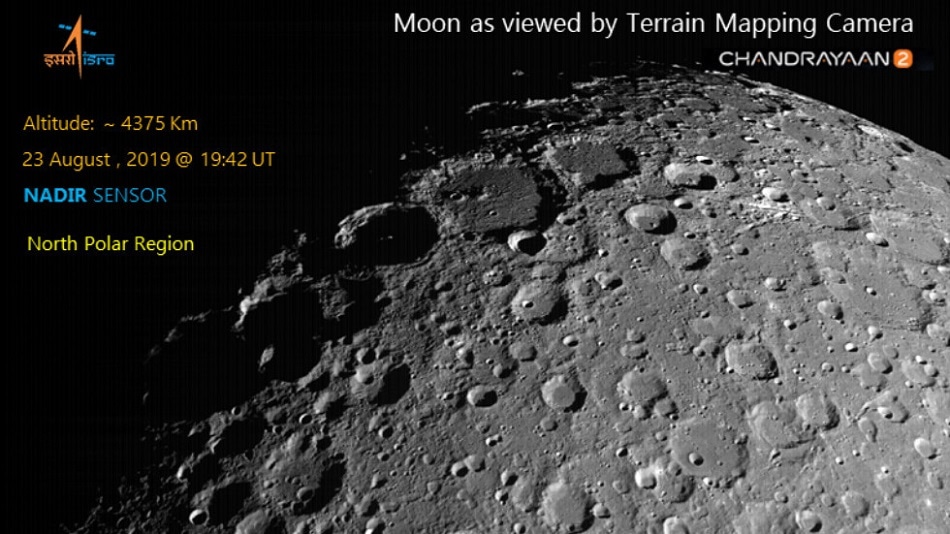 The moon's north polar region. Image Credit: © ISRO
The moon's north polar region. Image Credit: © ISRO
Boldly going where no other lunar mission has gone before, the moon’s south polar region, India’s Chandrayann-2 has transmitted fresh images of the surface of Earth’s natural satellite. Captured using the spacecraft’s Terrain Mapping Camera (TMC-2) the snaps were taken from an altitude of around 4375 km above the lunar surface.
Having recently entered elliptical orbit after successful Lunar Orbit Insertion (LOI), Chandrayaan-2 is currently performing a series of maneuvers as it prepares to enter its final circular orbit on September 1st. The Indian Space Research Organisation (ISRO) states it is attempting “to foster a new age of discovery, increase our understanding of space, stimulate the advancement of technology, promote global alliances, and inspire a future generation of explorers and scientists.”
The latest cratered images clearly show a range of significant lunar landmarks and large impact craters, including the Mach and Mitra craters as well as the Jackson impact crater in the northern hemisphere of the moon. The Jackson crater measures at 71 km in diameter and like all impact craters was formed by smaller celestial bodies such as meteorites colliding with the lunar surface.
The Mach crater is of particular interest due to a curious feature of its outer rim.
The interesting feature at the western outer rim of Mach crater is another impact crater, Mitra (92km dia). It is named after Prof. Sisir Kumar Mitra, who was an Indian physicist and Padma Bhushan recipient known for his pioneering work in the field of ionosphere and radiophysics.
ISRO
The images beamed back also feature the large Kolev crater which at 437 km in diameter contains numerous smaller craters scattered across their terrains. Also visible, located in the farside northern latitudes of the moon, is the Sommerfield crater, which is named after Dr. Arnold Sommerfeld who is a German physicist known for his work in atomic and quantum physics.
Located at 65.2°N and 162.4°W, the Sommerfield crater has a “relatively flat interior surrounded by a ring mountain and number of smaller craters along the outside edge.” ISRO also noted that “another well-formed impact crater”, the Kirkwood crater, “named after American astronomer Daniel Kirkwood,”, which is 68 km in diameter is nearby northeast to the Sommerfield crater.
Having recent entered orbit after a successful Lunar Orbit Insertion (LOI), Chandrayaan-2 is currently performing a series of maneuvers as it prepares to enter its final circular orbit on September 1st. Then, on September 7th, the attempt will be for the lander Vikram to make a soft landing on the surface of the moon in the South Pole region.
Once the mission touches down in a high plain between two craters, Manzinus C and Simpelius N, the solar-powered rover, Pragyan, will be sent out to roam the surface. Over 14 days, the rover is expected to travel half a kilometer from the lander, snapping photos and collecting data as it moves along.
The particular interest of the Moon’s South Pole region is that because this part of the surface mostly remains in shadow there is further potential for the presence and discovery of water.
The South Pole region has craters that are cold traps and contain fossil records of the early solar system.
ISRO
The hope is that the further extensive mapping and study of the moon could lead to explanations of its origin.
If the Chandrayaan-2 mission is successful, India will become the fourth country to complete a soft landing on the Moon, after the US, USSR, and China.
Disclaimer: The views expressed here are those of the author expressed in their private capacity and do not necessarily represent the views of AZoM.com Limited T/A AZoNetwork the owner and operator of this website. This disclaimer forms part of the Terms and conditions of use of this website.